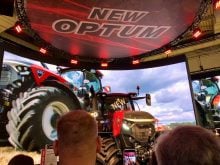Gerry Kraay chose the lab over the barn, after learning first-hand about farm life as a boy in Holland.
Kraay, who received masters and doctorate degrees in animal science, blood typing and genetics in Holland, served as director of the genetics branch of the Saskatchewan Research Council, or SRC, until his retirement in 2000.
“Having been raised on a dairy farm, I knew it was a seven-day, 24-hour-a-day job,” said Kraay, inducted into the Canadian Agricultural Hall of Fame in November 2002 for his work in the science of livestock parentage testing.
Read Also

Agritechnica Day 2: The future of tractor power, building quicker crop apps and large farms and tech
Agritechnica Day 2: The future of tractor power, building quicker crop apps with Syngenta and large farms and tech
“I feel most honoured by this,” said Kraay, whose wife, Dineke, and four sons attended the ceremony in Toronto.
Since immigrating to Canada in 1967, Kraay worked in blood typing labs at the University of Guelph and in Ottawa before moving to Saskatoon.
He explained how blood and DNA typing can be used to weed out negative traits and improve cattle production.
“You can use it as a tool in selection,” he said of the Saskatoon lab that employs 10 workers and handles 30,000 samples each year.
A correct match with the animal’s parents confirms the pedigree and a certificate is issued to verify the result. In about 10 percent of cases, profiles do not match and the real detective work begins, helped by the lab’s database of 300,000 records.
Looking back on his career, Kraay listed highlights that included establishing the Bovine Blooding Typing Lab (now called Bova-Can Laboratories) in Saskatoon in 1987 after its privatization and move from Ottawa.
He said a shortage of funds limited the amount of research that could be done, so a consortium of cattle breed associations created Bova-Can in a 50-50 venture with the SRC. It offered diagnostic services and parentage testing.
The lab has served many farmers and ranchers over the years, and has expanded to include a plant DNA lab called Genserv, once supervised by Kraay.
“It gives you great satisfaction,” said Kraay, who has been involved in training workers and setting up similar facilities around the world.
“I’m especially proud of the way I’ve built up the lab and provided service and have it accepted by farmers.”
He noted the importance of genetic testing to livestock breeders across the country. The lab has built a reputation internally for guaranteeing the lineage in embryo transfers and semen sales, and contributed to export markets.
Also, he cited a conference he organized in 1999 that focused on pedigreed studies and the switch to tests based on DNA parentage.
At the time, there was an undercurrent worldwide to replace traditional blood typing with DNA testing, which is possible on hair and tissue, he explained. The Saskatoon lab now has an extensive database.
“It’s a national treasure house really,” Kraay said, noting it allows scientists to use DNA to look for defects in a line, match up parents and offspring and determine if pedigrees are accurate.
“It’s a real support for cattle exports.”
Kraay hopes one day superior animals can be identified the day they are born through DNA testing.
“Given time and money, something in that direction will surely come.”
The livestock industry in Canada is among the best in the world and much of the Canadian stock is seen in herd development overseas. Today it is not uncommon for Canadian farmers to import semen from desired European bulls “as they’ve improved some things we haven’t,” said Kraay.
Commenting on changes witnessed, he noted the introduction of exotics, which That led to better weight gain in cattle, going to four pounds per day of gain from one to two lbs in the early days of his career.
Dairy production also has improved to 8,000 kilograms of milk per cow from 4,500.
“Animal breeding really has progressed by leaps and bounds in the last 30-40 years,” he said.
Yves Plante of Bova-Can called Kraay a dedicated researcher who was instrumental in establishing the blood typing lab.
He had the vision to move toward DNA typing in the late 1980s and to diversify the lab to include other livestock testing, said Plante.
“He was always at the forefront of emerging technologies that could be useful to the livestock industry.
“He was curious, ” said Plante. “A typical good scientist, he just wants to know.”
Kraay still keeps abreast of the latest research and does consulting, but these days is mainly involved with family, his church and community service work.














